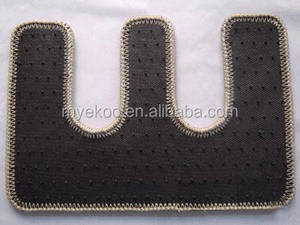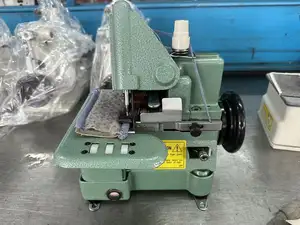Types of Carpet Binding Machines
Carpet-binding tools have evolved over the years since the binding was initially done by hand with a needle and thread. There are even carpet repair kits for practical users who want to do minor repairs on their carpets. Many of these machines are specially designed for heavy-duty industrial and commercial use.
It is crucial for buyers to note that these machines perform different tasks and are suited for different types of jobs.
Handheld Carpet Binding Machines
These small, portable machines are designed for quick and simple binding tasks. They use adhesive to attach fabric to the edges of a carpet, making them ideal for repair jobs or small-scale projects.
- Portability: Easy to move around and store.
- Speed: Quick for small repairs but not suitable for large volumes.
- Power source: They can be electric or battery-operated.
- Application: Best for small workshops or DIY enthusiasts who need a machine for light binding.
Automatic Carpet Binding Machines
These machines are powered by electricity and are designed to speed up the binding process by automatically feeding and stitching the carpet edges. Automatic machines are used for larger projects, requiring consistent quality and faster production rates.
- Production capacity: High productivity, suitable for mass production.
- Cost: Larger initial investment but lowers labor costs in the long run.
- Application: Ideal for large factories that require high-speed, high-volume production.
Manual Carpet Binding Machines
These machines are operated by hand, requiring the user to guide the carpet through the binding process. Simple and reliable manual machines are suitable for small to medium-scale projects.
- Cost: Generally more affordable than automatic machines.
- Skills required: Requires skilled labor for efficient operation.
- Application: Suitable for medium-sized businesses that require a moderate production capacity.
Commercial Carpet Binding Machines
These heavy-duty machines are specifically designed for industrial environments. They are built to handle large volumes of carpet and fabric with speed and efficiency.
- Durability: Built to last, with high-quality components that can withstand daily use.
- Application: Great for companies in flooring installation, carpet manufacturing, or large-scale hospitality businesses.
Industry Applications of Carpet Binding Machines
Manufacturing and Production
- Efficiency: Automatic machines aid in mass production without compromising quality.
- Scale: High-capacity production aligns with large-scale manufacturing demands.
Flooring Installation and Retail
- Versatility: Machines capable of binding various materials serve diverse customer needs.
- Custom solutions: Offer personalized carpet designs with custom binding, enhancing value for customers.
Hospitality and Commercial Real Estate
- Consistency: Bindings of the same quality are ensured across large areas, promoting uniformity in appearance.
- Durability: High-quality binding extends carpet life, yielding cost-effectiveness through reduced replacement frequency.
Retail and E-commerce
- Customization: Offer unique binding options for various carpets, giving a personal touch that attracts customers.
- Specialization: Binding machines meant for area rugs facilitate the sale of specialized, niche products.
Restoration and Repair Services
- Quick fixes: Handheld machines allow instant repairs, which are highly useful in an emergency restoration business.
- Portable solution: Easy transport of machines lets on-site repairs, increasing service efficiency.
Creative Industries and Art Projects
- Innovation: Allow the use of non-traditional materials like fabric or jute, promoting creative, out-of-the-box projects.
- Customization: Tailored bindings for artistic carpets increase their value, providing unique, creative outcomes.
Product Specifications and Features of Carpet Binding Machines
Technical Specifications
- Binding width: The binding width varies per machine, with common widths ranging from 1 to 5 inches. This measures the fabric width that the machine can stitch onto the carpet edges.
- Stitch length: The stitch length can usually be adjusted and ranges from 1/8 to 1/2 inches. This sets how far apart each stitch will be, affecting the binding's tightness and appearance.
- Speed: Automatic machines can have carpet binding speeds of up to 30 stitches per minute. This number means how fast the machine can bind the carpet, showing its overall performance.
- Power source: These machines can run on electricity or be battery-powered. Commercial models typically use a lot of electricity, while portable ones often run on batteries.
- Material compatibility: Binding materials can be cotton, polyester, or jute. These materials help ensure the machine works with different fabrics for various binding needs.
How to Install
- Assemble parts: Attach any loose machine parts, following the manual to ensure the binding machine's proper setup.
- Set power source: For electric machines, connect to a power supply while ensuring battery machines are charged. This sets the machine to receive power for binding work.
- Adjust settings: Set the binding width and stitch length to desired levels. These initial adjustments prepare the machine to bind the carpet as required.
- Insert binding: Place the binding material as directed. This step gets the material ready for the binding process.
- Test run: Do a short test on a carpet scrap to check the settings and make any small changes if needed. This final step ensures the machine is fully prepared before starting work.
How to Use
- Prepare carpet: Cut the carpet to the desired size before starting to make binding easier.
- Select binding: Pick the binding material, such as jute or cotton, according to the binding machine. This choice supports a smooth binding process.
- Attach binding: Following the machine guidelines, attach the binding material to the machine. This step is crucial for starting the binding task.
- Load carpet: Place a carpet strip into the machine as per the instructions. This gets the carpet ready for binding.
- Start binding: Turn on the machine and carefully guide the carpet through it to avoid any problems.
Maintaining< CARPET BINDING< MACHINES
- Regular cleaning: Clear away any dust or carpet pieces frequently. This helps the machine work without problems.
- Check for damage: Often look at the binding area for any worn or broken parts. This way, users can fix things before they cause issues.
- Oil moving parts: Add some oil to parts that move according to the manual directions, ensuring smooth functioning.
- Inspect belts: Regularly check belts for signs of wear and tear. Replace them to ensure no binding errors occur.
- Storage rules: Keep the machine covered when not in use to prevent dust and dirt from entering.
Carpet Binding Machine Selection Strategies
- Assess binding needs: Choose a machine based on binding width and speed to match the project size and binding material.
- Evaluate power type: Select electric machines for high-speed, large-scale work, and portable, battery-powered machines for quick, small tasks.
- Check material compatibility: Ensure the machine handles binding materials, including cotton, jute, or polyester, for different carpet types.
- Scaling production: Choose commercial machines for large-scale production to enhance durability and output. For smaller operations, manual or semi-automatic machines work perfectly.
- Budget considerations: Set a budget and select machines within that range, considering future growth that might require a larger machine.
- Space requirements: Assess the workspace size, picking compact machines for limited areas and larger ones for bigger spaces.
- Durability and quality: Invest in high-quality, durable machines to ensure long-term, heavy usage.
- Maintenance ease: Choose machines that are easy to maintain to avoid long downtimes.
- Commercial vs. custom: Select commercial-grade machines for business uses and custom machines when special requests come up often.
Q & A
Q1: What's the key difference between automatic and manual carpet binding machines?
A1: Automatic machines bind faster and usually with more power than manual machines, which need to be pushed through by hand.
Q2: Can carpet binding machines be used with other materials besides jute?
A2: Yes, binding machines can use cotton or polyester along with jute, depending on the project materials in question.
Q3: How often should a carpet binding machine be serviced?
A3: Regular maintenance, like cleaning and lubricating, should happen often every few uses. This keeps the binding machine working well.
Q4: Are handheld carpet binding machines good for large carpets?
A4: Handheld machines may be slow for big jobs. Larger binding would be better served by automatic or commercial machines.
Q5: Do carpet binding machines come with warranties?
A5: Most new machines have warranties. These cover any parts that wear out or break under normal use.










































































































































































































